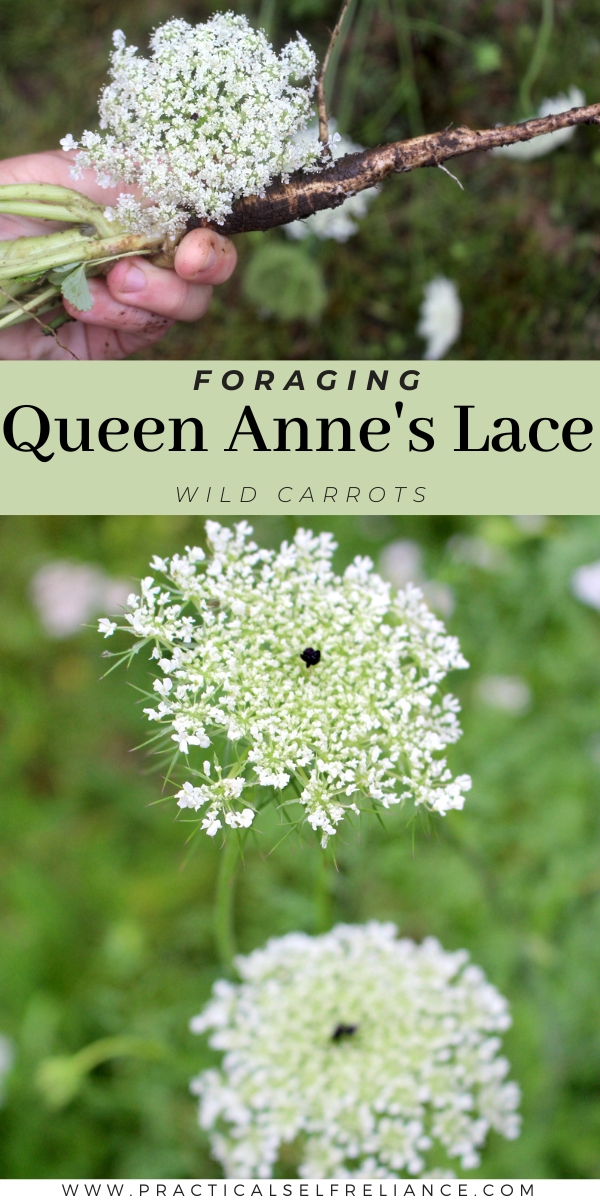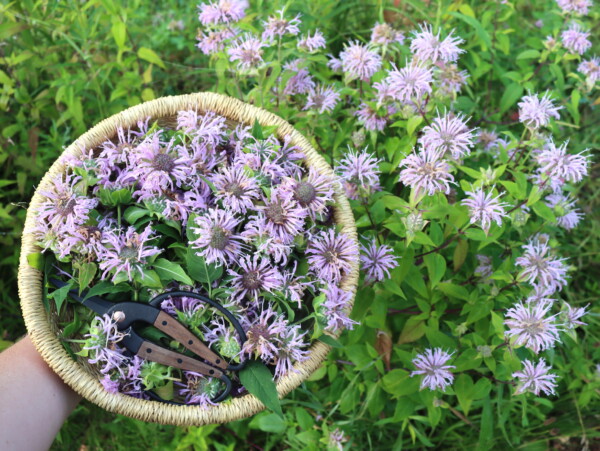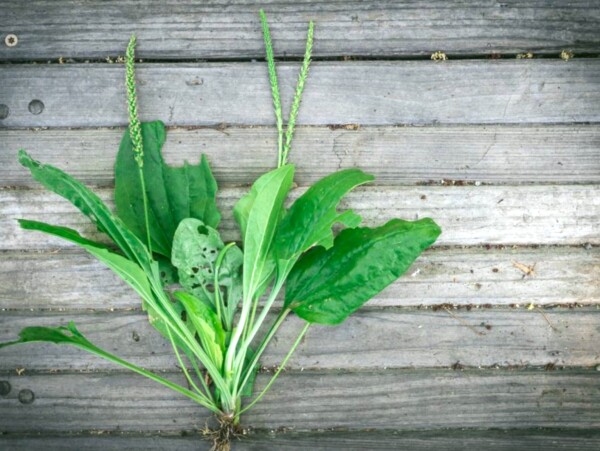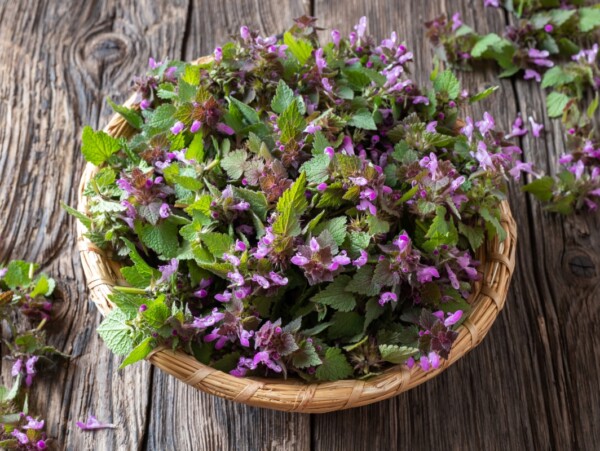Affiliate disclosure: This post may contain affiliate links. Please see our Privacy Policy.
Queen Anne’s Lace, also known as “Wild Carrot,” is a common edible wild weed that grows all over the world. Every part of Queen Anne’s Lace is edible and quite tasty, but it can be tricky to tell it apart from other toxic look-alikes, namely deadly poison hemlock. Still, there are a few very easy-to-spot indicators that make it easy enough to tell the difference, so long as you’re paying attention.
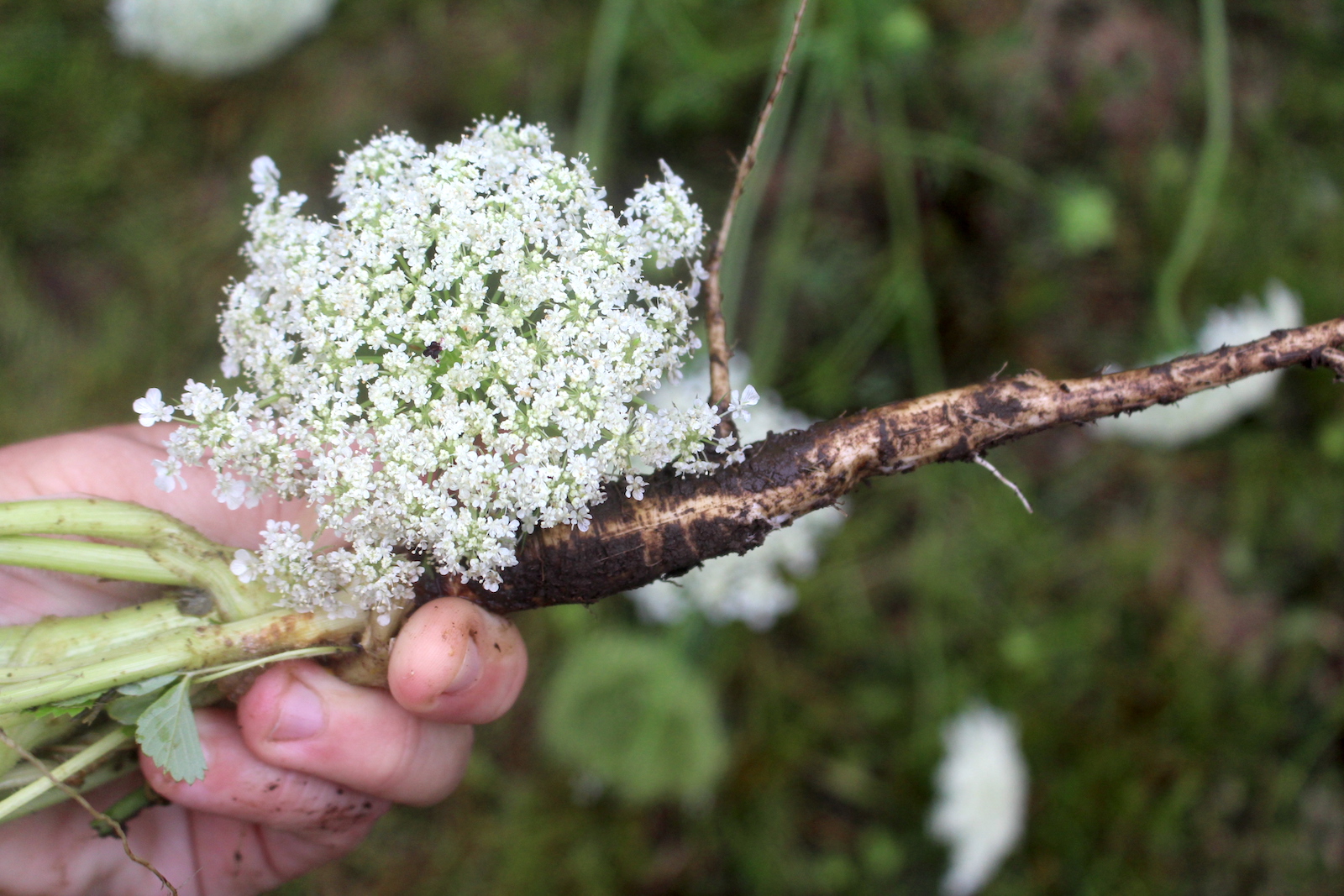
One of the most common wild weeds in the world, Queen Anne’s lace covers roadsides and fields in much the same way as wild dandelions. Modern cultivated carrots are a subspecies of these wild carrots, and the entire plant is edible.
Queen Anne’s Lace is just one of more than 20 edible wild roots, tubers, and bulbs that we forage in season.
While it does have toxic look likes, a little attention to detail will allow you to safely forage this tasty wild food source. And if you’re not confident in your ID, obviously don’t eat it.
The safest part of this plant is the beautiful white flowers in season. While there are plenty of white flower clusters this time of year, there is no other flower that has a look of delicate white lace with a dark blood-red central flower.
The flowers themselves can be used just like any edible flower, adding flavor to everything from salads to desserts.
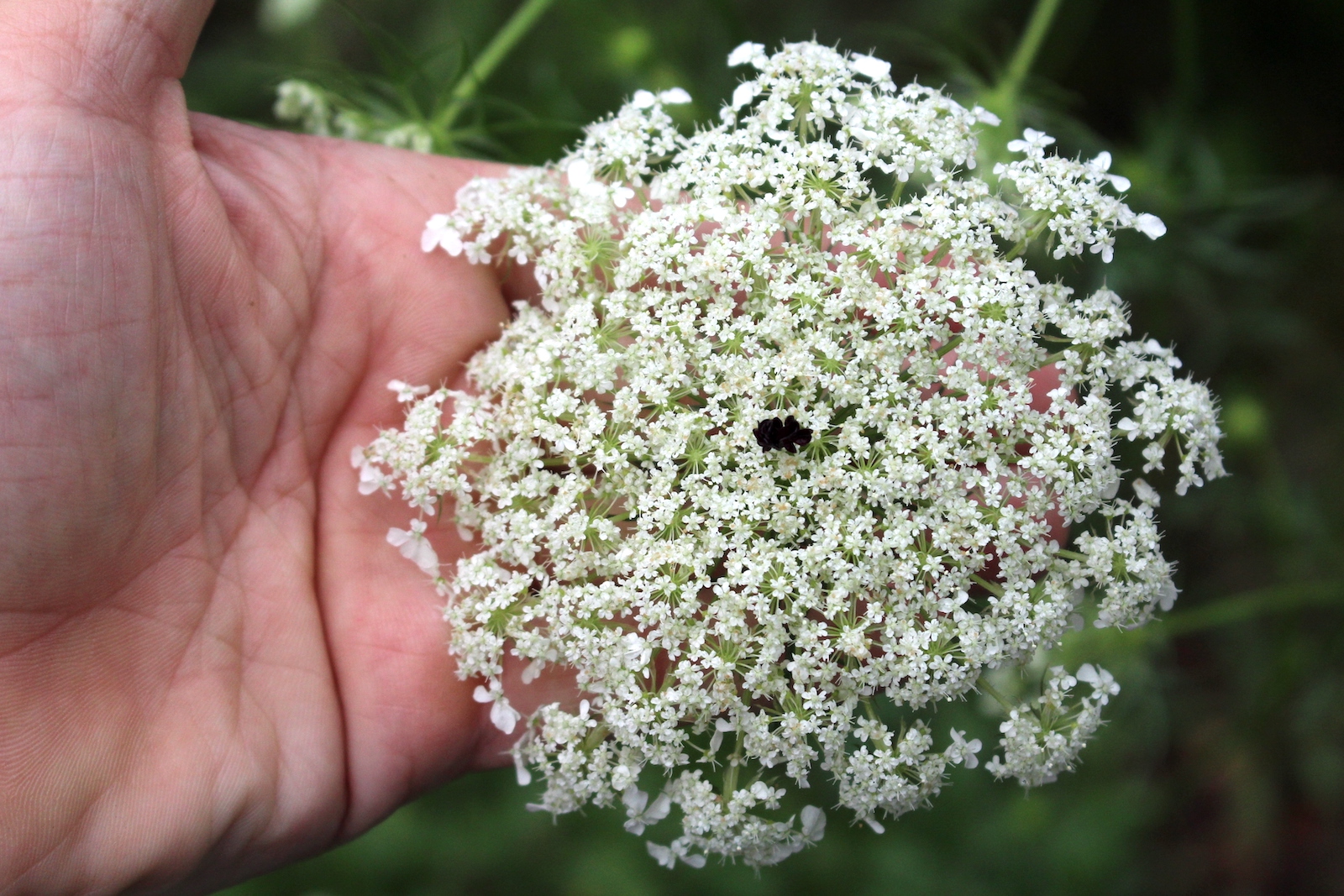
When foraging any wild plant, it’s important to be 100% certain of your identification. That’s especially true when plants have toxic look-alikes. In the case of Queen Anne’s Lace, those look-alikes are deadly toxic. There are easy-to-spot ways to positively ID Queen Anne’s lace and distinguish it from look likes, but that works takes time and attention. Do not just casually harvest this plant en-masse without carefully checking each and every one.
If you’re new to foraging wild plants, I’d suggest taking the Botany and Wildcrafting Course from the Herbal Academy. It takes you through all the relevant plant identification terminology and will give you a solid foundation for getting out there and finding wild plants.
Be aware that foraging Queen Anne’s Lace can be done safely with attention to detail, but it’s not for beginners.
What is Queen Anne’s Lace?
Queen Anne’s Lace (Daucus carota) is an herbaceous biennial weed that’s a member of the Apiaceae or Umbelliferae family, commonly known as the carrot, celery, or parsley family. It’s native to the temperate regions of Southwest Asia and Europe and has naturalized in North America and Australia.
You may hear Queen Anne’s Lace called several common names depending on where you live, including Wild Carrot, Bee’s Nest Plant, Devil’s Plague, Bird’s Nest, Bishop’s Lace, and European Wild Carrot.
Domesticated garden carrots are a subspecies of queen Queen Anne’s Lace.

Is Queen Anne’s Lace Edible?
Yes, Queen Anne’s lace is entirely edible. Queen Anne’s Lace’s roots, leaves, flowers, and seeds can be used.
However, the leaves can cause skin irritations and photosensitivity in some people. That is also true of a number of cultivated relatives, namely parsnips and garden carrots.
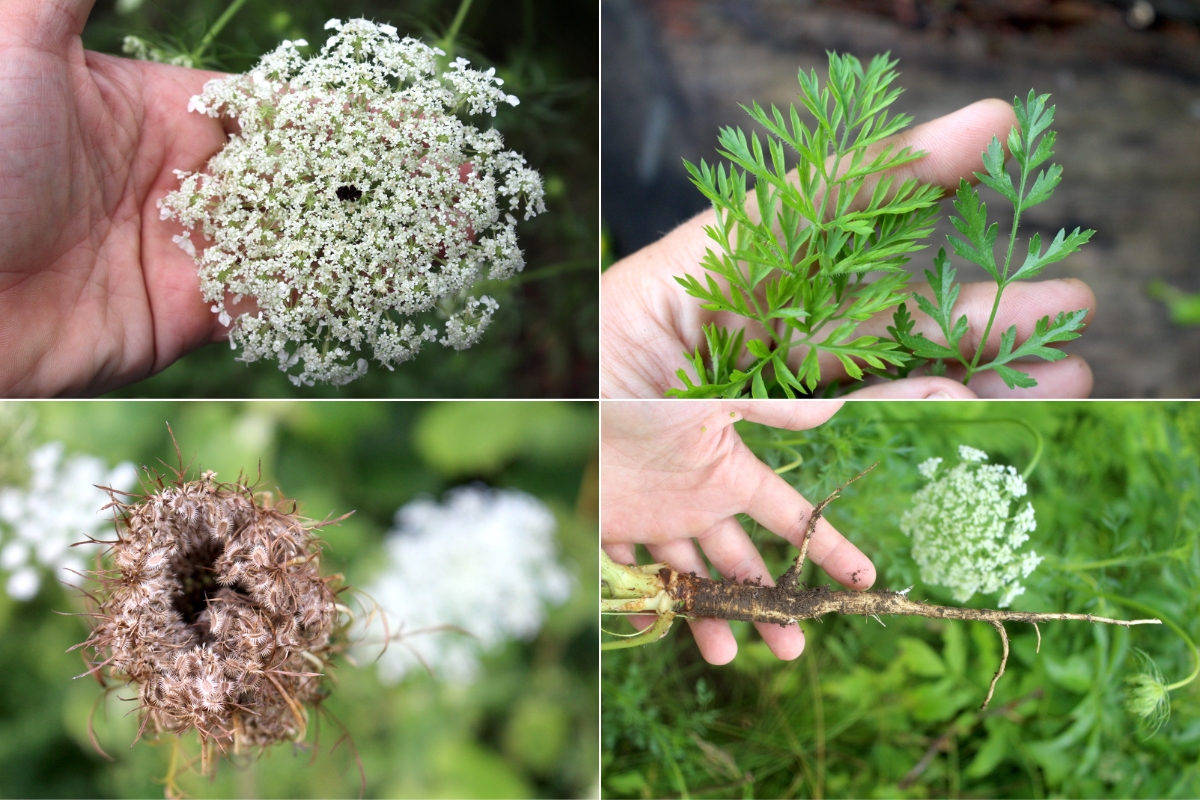
The leaves are generally used like a pot herb and cooked in soups and stews. When harvesting the roots and leaves, it’s best to find young plants in their first year of life that haven’t flowered. The roots of older plants become tough and woody, and the leaves can become bitter.
Queen Anne’s Lace, specifically the seeds, also has a long history in herbal medicine and has been used to treat various ailments including as an abortifacient or to prevent pregnancy. For this reason, women who are pregnant or breastfeeding should avoid Queen Anne’s Lace.
Queen Anne’s Lace often dots roadsides and medians, and harvesting from these places can be tempting. However, it’s best to avoid picking from these areas because Queen Anne’s Lace can accumulate toxins from vehicles and other pollution that may have leached into the soil in these places.
Queen Anne’s Lace also has a couple of deadly look-a-likes that I’ll cover below, so you should only harvest it if you are 100% certain of its identity. This is not a plant to forage casually, and you really need to practice attention to detail when working with this plant.
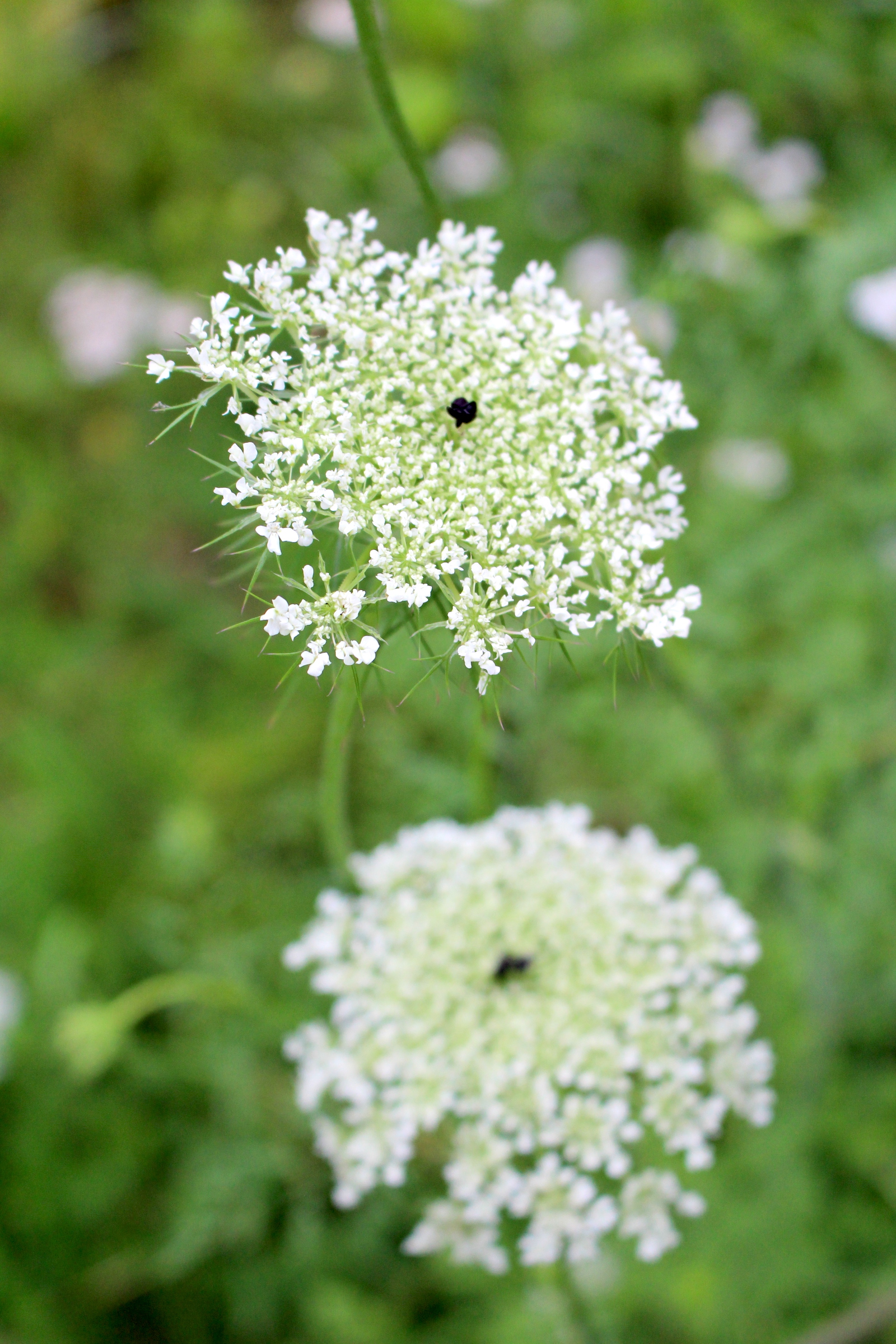
Queen Anne’s Lace Medicinal Benefits
Queen Anne’s Lace isn’t very popular among modern herbalists, but it was an important plant in traditional herbal medicine. Historically, herbalists used Queen Anne’s Lace to treat digestive, urinary tract, cardiovascular, and hormone issues.
It was believed to have carminative, diuretic, and stimulating effects. Additionally, it was employed to prevent pregnancy or as an emmenagogue to cause an abortion.
Herbalists also used the plant externally. Queen Anne’s Lace was believed to have antiseptic properties. Some practitioners grated the roots and mixed them with oil to place on burns.
Early references to Queen Anne’s Lace seeds to prevent pregnancy or cause abortions date back to the 4th or 5th centuries. In his works from over 2,000 years ago, Hippocrates recommends taking crushed Queen Anne’s Lace seeds to prevent pregnancies. A modern study completed in 2014 appeared to validate this usage and explored the anti-fertility effects of Queen Anne’s Lace though the researchers noted that further study is still needed.
When used to “bring the menses,” there is a very specific protocol involved, and it’s not as simple as just taking a few seeds and calling it a day. Avoid this herb if pregnant, but also don’t assume that it’s an easy-to-use contraceptive herb…it’s more complicated than that.
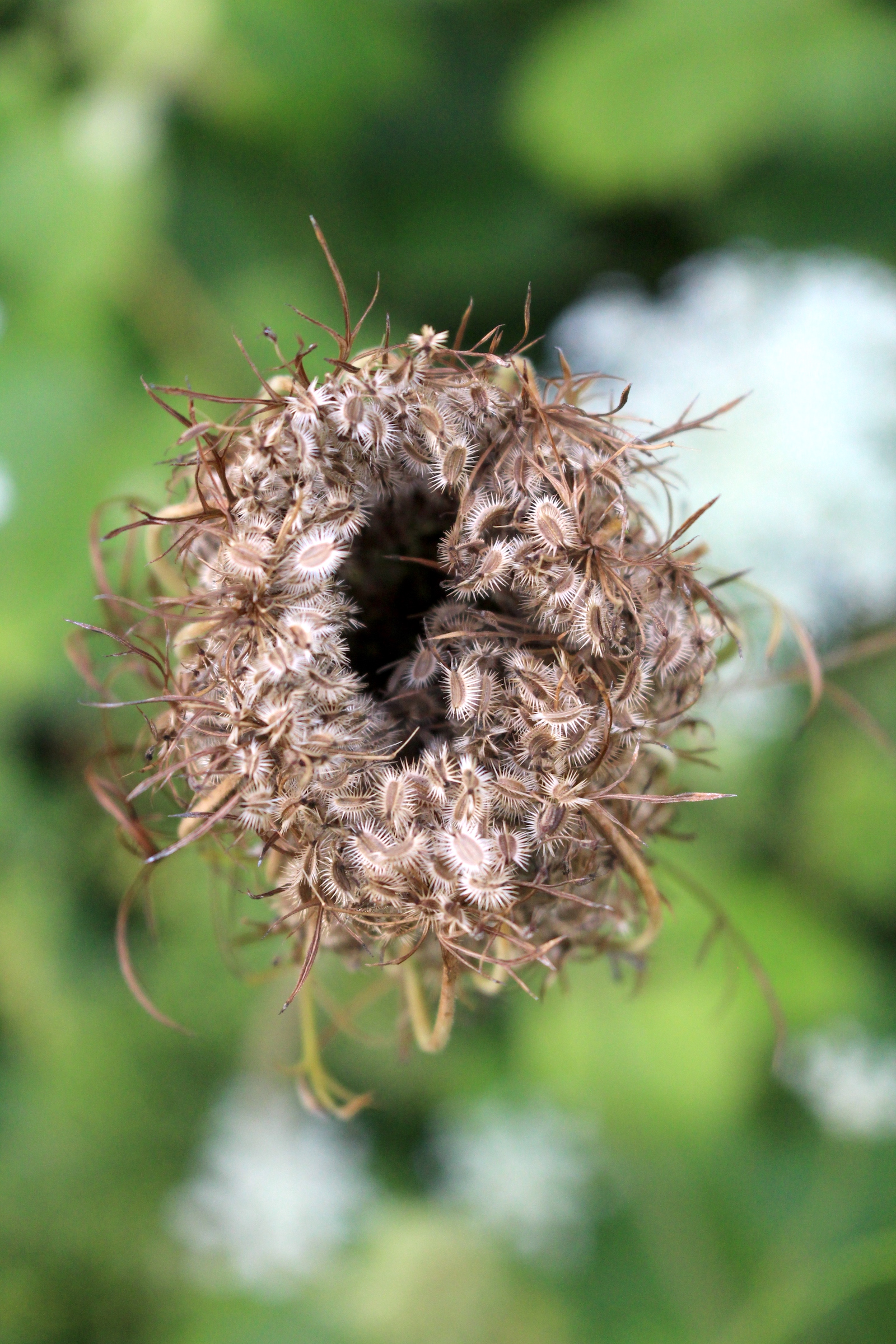
Queen Anne’s Lace is believed to have diuretic properties, which may be what helps with various urinary tract issues. It stimulates the kidneys and increases urine output. This may help people recover and heal from kidney stones, UTIs, and similar ailments.
There are also some accounts of Native Americans using Queen Anne’s Lace after it began to naturalize in North America. The Cherokee reportedly used it to treat skin problems. In contrast, the Delaware used an infusion of the fresh blossoms to treat diabetes, and the Iroquois used the roots in a decoction to treat blood disorders.
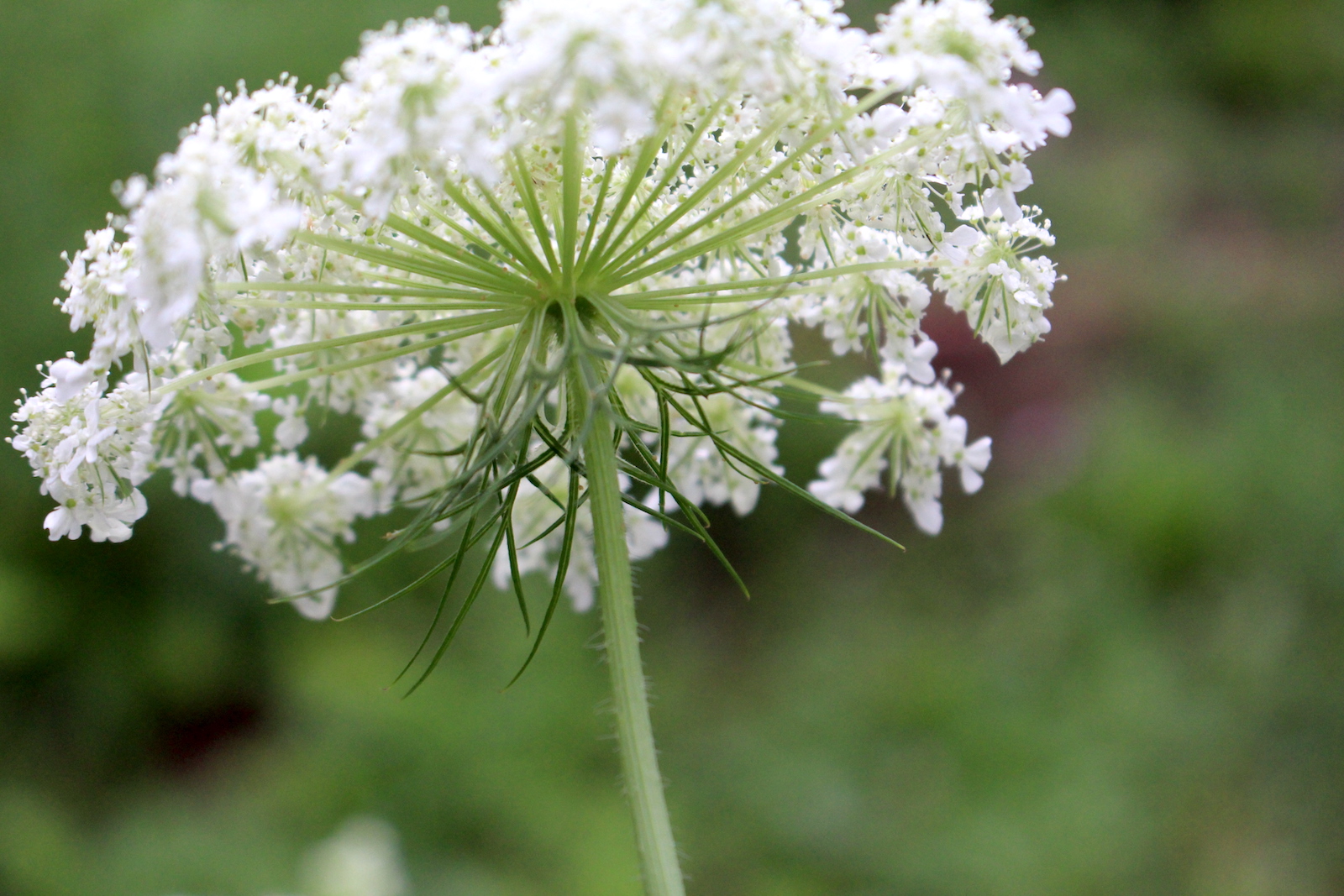
Where to Find Queen Anne’s Lace
Queen Anne’s Lace can be found throughout its native range in Southwest Asia and Europe, as well as where it has naturalized in North America and Australia. In North America, Queen Anne’s Lace can be found throughout the lower 48 states as well as the southern provinces of Canada.
Queen Anne’s Lace is a hardy plant and thrives in sunny areas with poor, dry soils. You may find it in fields, meadows, waste areas, roadsides, woodland edges, and other disturbed habitats.
When to Find Queen Anne’s Lace
During the plant’s first growing season, it forms a low, basal rosette of foliage and tap root. This first season is an ideal time to harvest the root. The leaves will stay green year-round; in southern areas, you may harvest Queen Anne’s Lace any time of year.
However, Queen Anne’s Lace doesn’t flower until its second growing season; this is when it’s easiest to locate and identify. In most of the lower 48 states, Queen Anne’s Lace will bloom from May to October.
Identifying Queen Anne’s Lace
As Queen Anne’s Lace only forms a basal rosette of carrot-like green leaves in its first growing season, it can be especially hard to spot amongst other herbaceous weeds unless you already know it’s growing there.
When in flower in its second growing season, Queen Anne’s Lace is easy to spot from a distance. It sends up relatively tall, flowering stems. It often grows in large patches or even entire fields, and the lacy white umbels of flowers put on a beautiful display.
Correct identification of Queen Anne’s Lace is critical as it has a couple of poisonous look-alikes, which we’ll discuss below.
While queen Anne’s lace is almost always a umbel of white flowers, there are occasional mutations, and I’ve sometimes seen pink Queen Anne’s lace blooms as well.
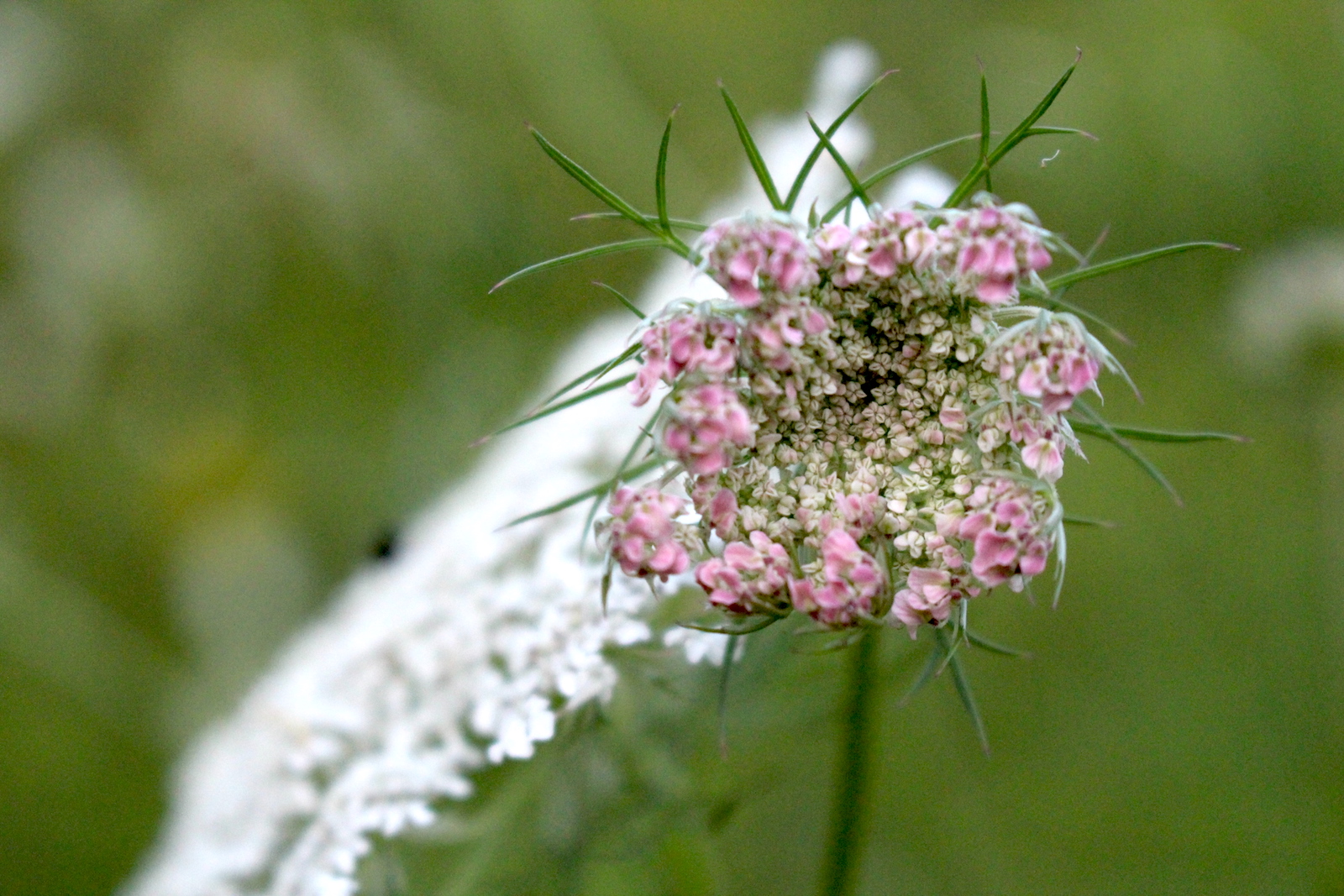
Queen Anne’s Lace Leaves
Queen Anne’s Lace leaves grow two to eight inches long and have a fern-like tri-pinnate pattern.
They grow in an opposite arrangement.
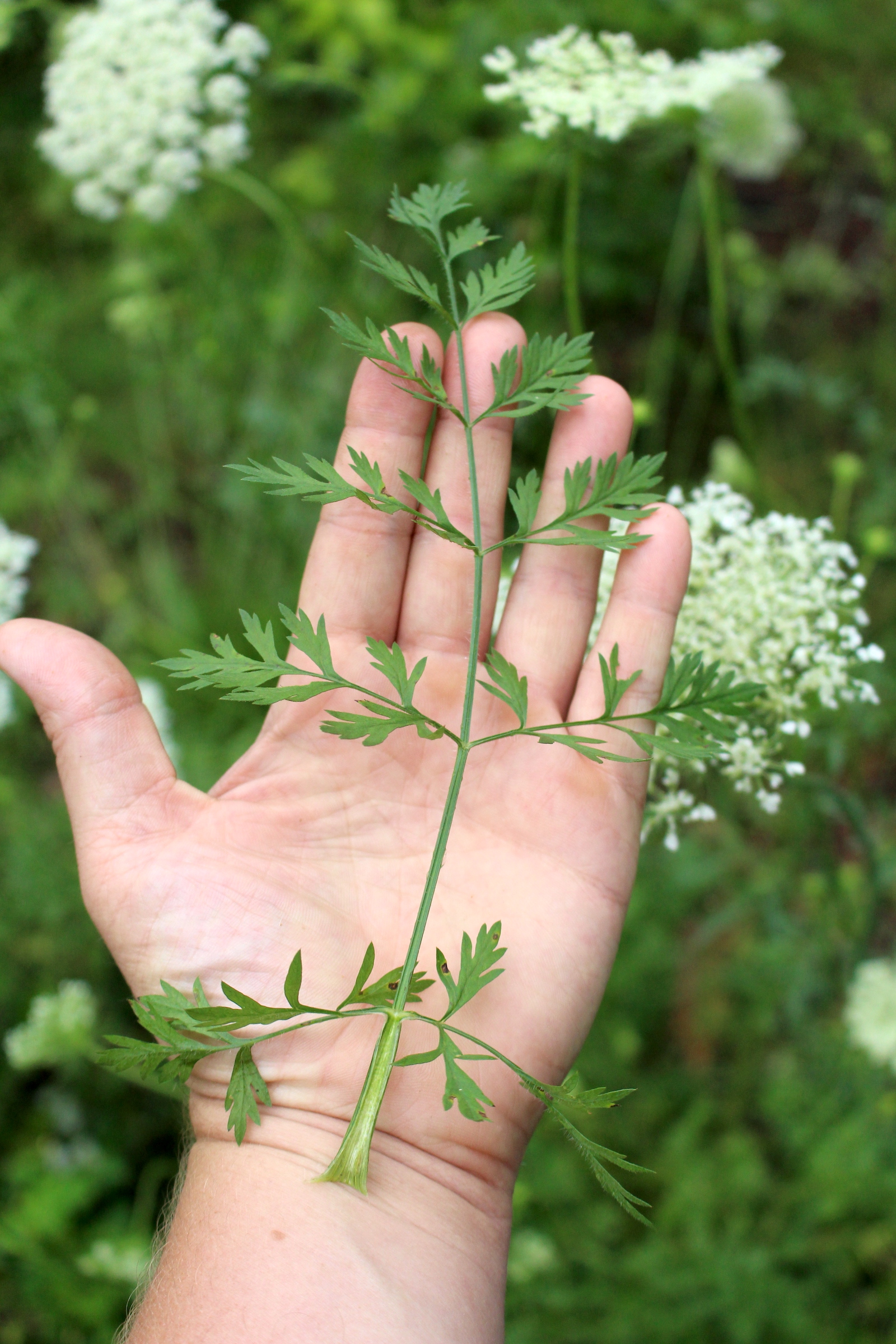
Overall, they have a triangular shape and resemble the leaves of a modern carrot.
Additionally, they have hairy undersides and exude a carrot-like odor when crushed.
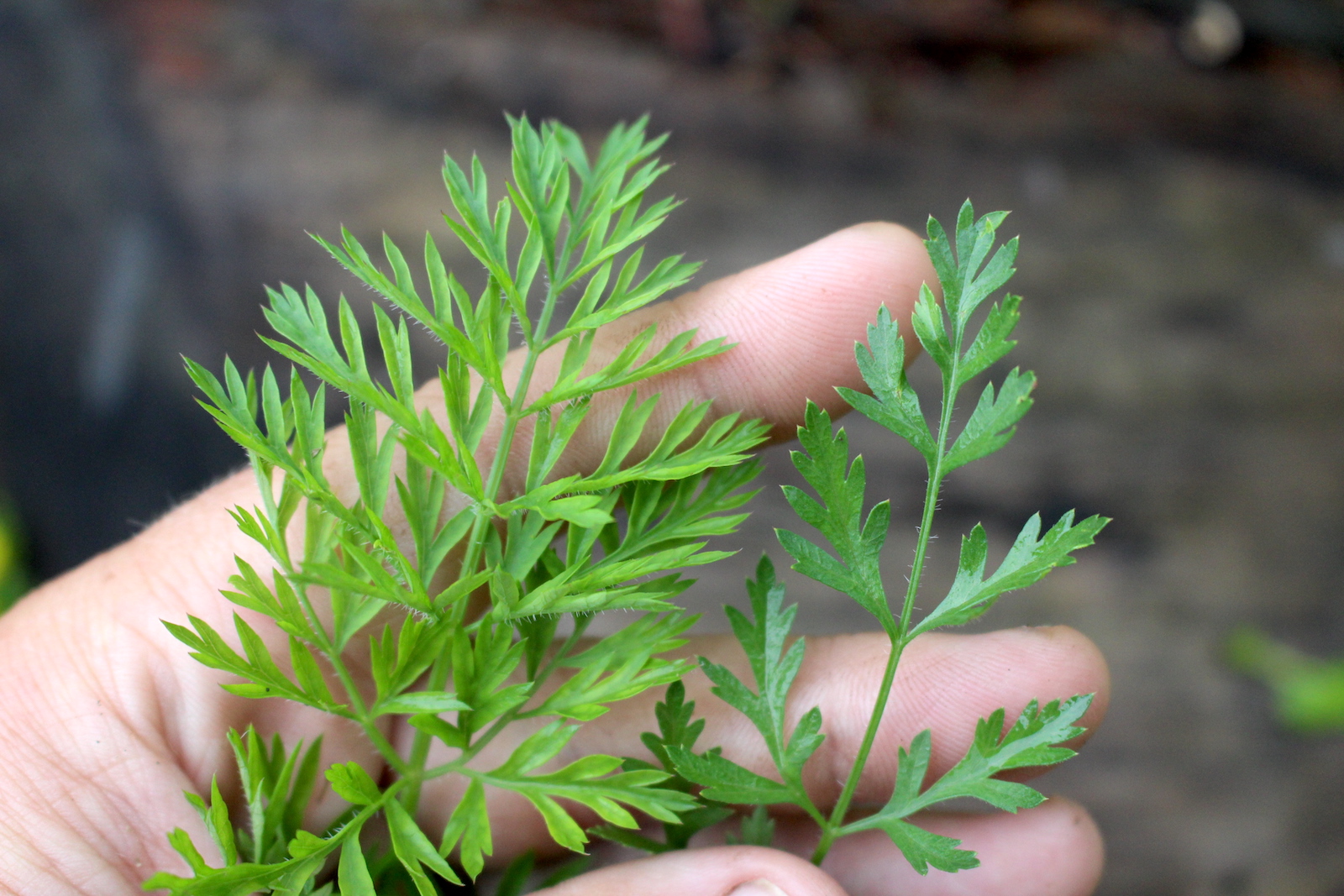
Queen Anne’s Lace Stems
Queen Anne’s Lace stems are rather stiff and sturdy and may grow between one and four feet tall. The stems are round, hollow, solid green, and hairy.
A fun way to remember this is that ladies of Queen Anne’s time didn’t shave, so they had hairy legs just as Queen Anne’s Lace does.
Queen Anne’s Lace Flowers
The flowers are lacy, flat-topped compound umbels of tiny white flowers that appear a bit like a flat, lace umbrella. They generally have a diameter of 3 to 5 inches.
They typically have one darker purple or red flower at the center. Legend says this was the drop of blood where Queen Anne pricked her finger while embroidering lace.

Each umbel has three-forked, leaf-like bracts beneath it.
When the flowers mature and fade, they fold in on themselves like a cup or nest, giving the plant its common name, Bird’s Nest or Bee’s Nest Plant.
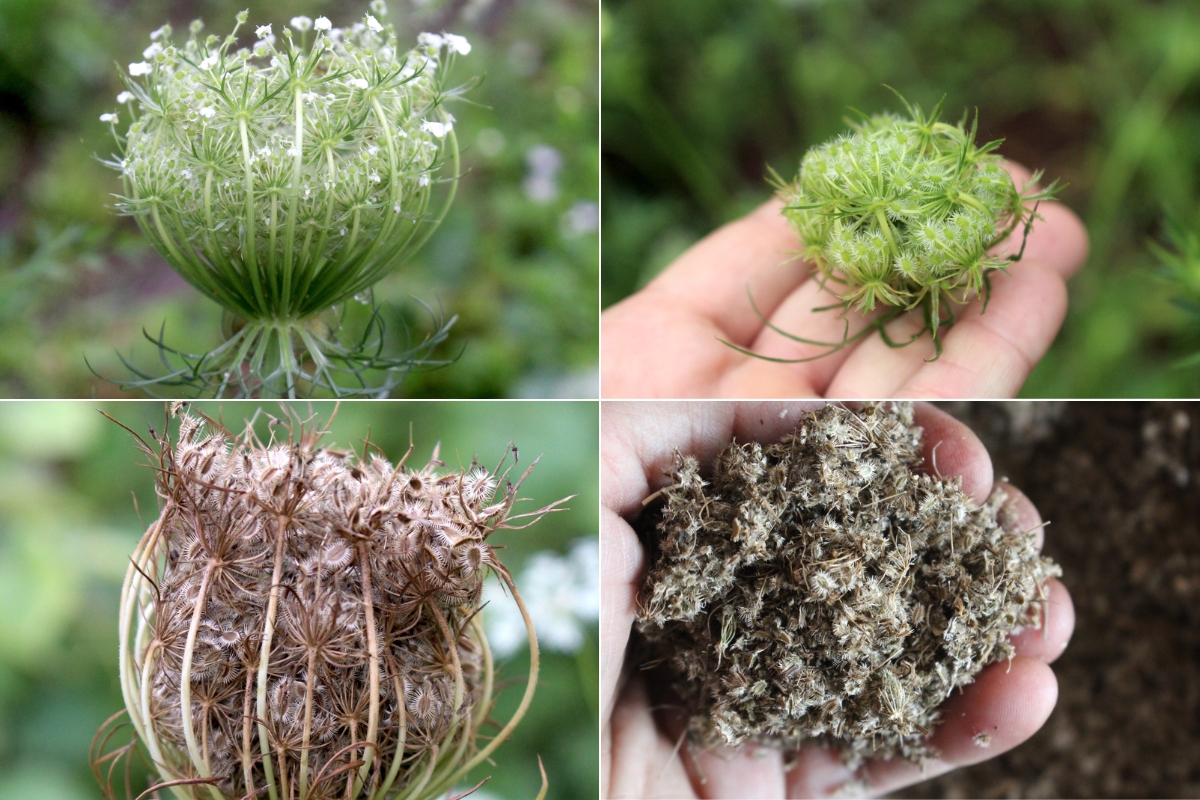
Queen Anne’s Lace Roots
As its common name Wild Carrot suggests, Queen Anne’s Lace is a relative of the domestic garden carrot and also produces an edible taproot.
However, the root of Queen Anne’s Lace isn’t as impressive as a domestic garden carrot. Instead, it has a firm, paler yellow, spindly taproot.
When crushed or broken, it has a carrot-like odor.
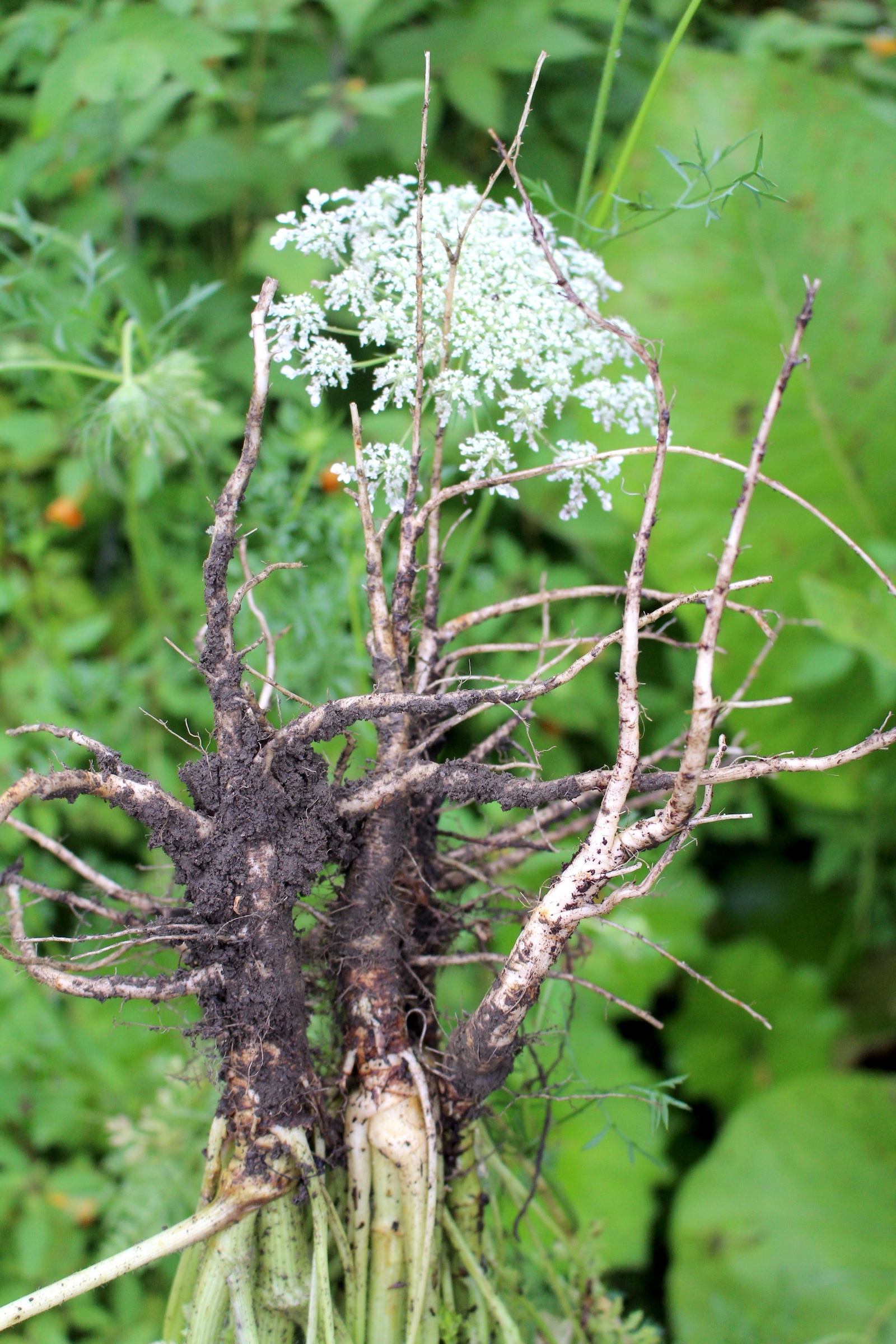
Queen Anne’s Lace Seed
Queen Anne’s Lace flowers give way to small, dry, bristly, seed-like fruits.
The fruits begin as a light reddish-purple and turn green to grayish-brown as they dry and then split into two segments.
The seeds can be used for flavoring, and they’re great on top of homemade crackers, but they’re also more commonly used medicinally.
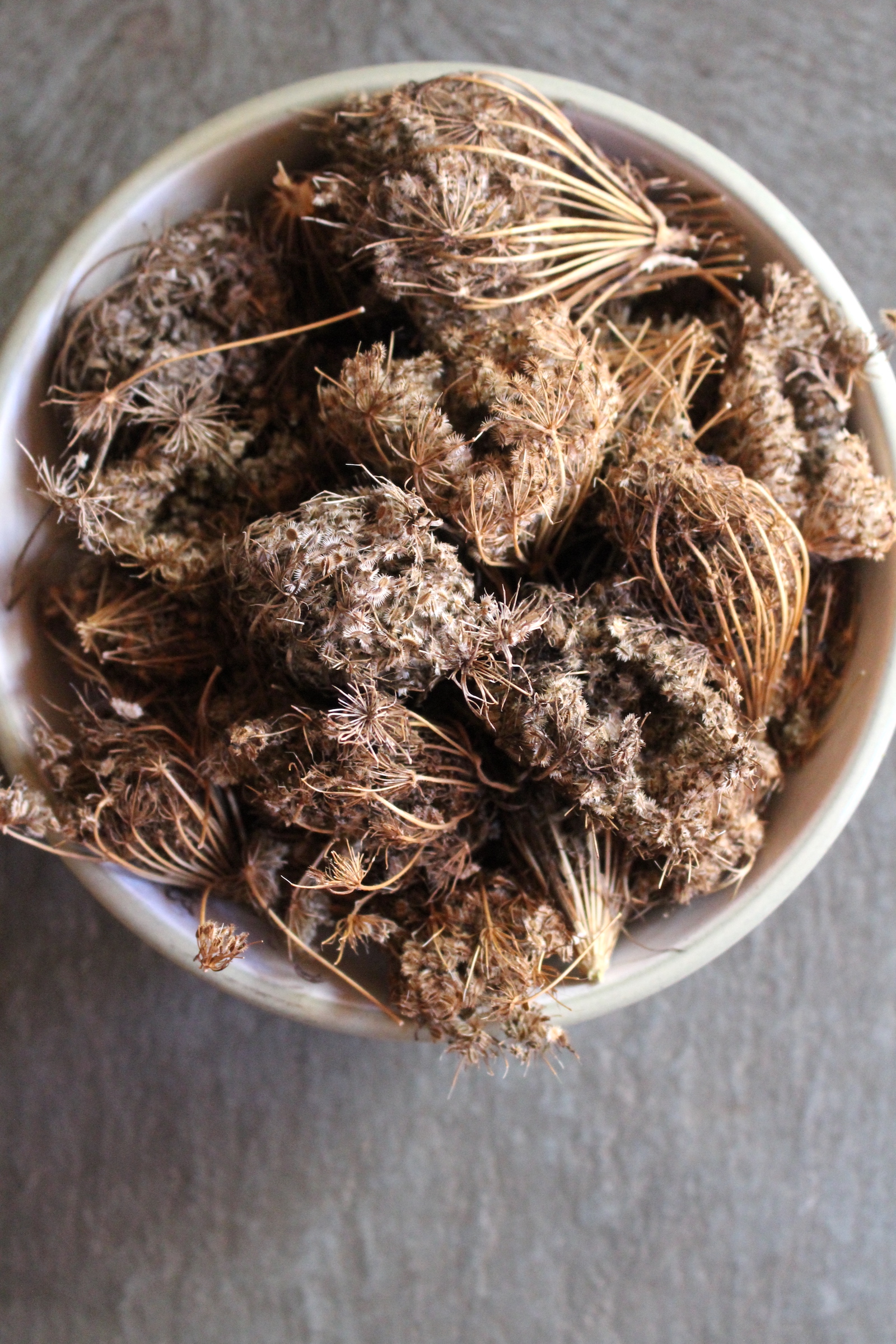
Queen Anne’s Lace Look-Alikes
Unfortunately, Queen Anne’s Lace has several lookalikes. While one is completely harmless, two others can be deadly if consumed.
Queen Anne’s Lace is sometimes mistaken for Water Hemlock (Cicuta sp.), a genius of highly poisonous plants. Thankfully, Water Hemlock differs in several noticeable ways:
- The stem of Water Hemlock is smooth with magenta streaks or mottling.
- The flowers of Water Hemlock are dome-shaped, loose compound umbels. Generally, this means that the flower almost looks like it’s made of several little umbrellas with stems that come together at the center. Queen Anne’s Lace, on the other hand, appears like one continuous, flat umbrella.
- The flowers of Water Hemlock lack the three-pronged bracts beneath them that are characteristic of Queen Anne’s Lace.
- The flowers lack the dark spot at the center, characteristic of Queen Anne’s Lace.
- Water Hemlock has a thick, multi-chambered rootstock and thick, fleshy tubers. The chambers of the rootstock contain a poisonous brown or yellowish oily liquid that is released when the chambers are broken or cut. The liquid smells like raw parsnips.
- The leaves of Water Hemlock lack any hair and have sharp-pointed, toothed leaflets with veins ending at the notches between the teeth.
Another deadly lookalike is Poison Hemlock (Conium maculatum). Fortunately, it also differs in a few key ways:
- Poison Hemlock has smooth, purple-spotted stems.
- The flowers of Poison Hemlock are small compound umbels. Generally, this means that the flower almost looks like it’s made of several little umbrellas with stems that come together at the center. Queen Anne’s Lace, on the other hand, appears like one continuous, flat umbrella.
- The flowers lack the dark spot at the center, characteristic of Queen Anne’s Lace.
- The flowers of Poison Hemlock lack the three-pronged bracts beneath them that are characteristic of Queen Anne’s Lace.
- Poison Hemlock leaves are smooth and lack the hairy undersides found on Queen Anne’s Lace.
A more friendly plant that can be mistaken for Queen Anne’s Lace is another common herbal ally, Yarrow (Achillea millefolium). It can be distinguished in the following ways:
- Yarrow leaves have an alternate arrangement.
- Yarrow leaves are delicate and feathery, and lack the triangular shape of the leaves of Queen Anne’s Lace.
- Yarrow has compound flowers made from 4 to 9 corymbs, each composed of 10 to 20 small flowers. (A corymb is a flower cluster where the individual flowers have stalks of different lengths to create the appearance of a flat top.) These small flowers generally each have 4 to 6 rays.
- The flowers lack the dark spot at the center, characteristic of Queen Anne’s Lace.
- The flowers of Yarrow lack the three-pronged bracts beneath them that are characteristic of Queen Anne’s Lace.
Queen Anne’s Lace may also be confused with Cow Parsnip (Heracleum maximum). However, it differs in a few easy-to-spot ways:
- Cow Parsnip grows very tall, and a mature plant can reach over 6 feet in height.
- Cow Parsnip has large, lobed leaves 10 to 15 inches wide that are divided into three segments.
- Cow Parsnip stems are deeply ridged or grooved, wooly, and may be green or slightly purple.
- The flowers are large and grow up to 1 foot in diameter.
- The flowers lack the dark spot at the center, characteristic of Queen Anne’s Lace.
I’ll also mention that Queen Anne’s Lace is often mixed in with other plants that flower in white clusters.
When I was photographing plants for this article, I found stalks mixed together with elderflowers and valerian. Both of those are edible, and the plants look very different, but the flower heads were right on top of each other and quite similar to a casual glance.
There are a lot of white flowering plants in mid-summer, so be sure you have Queen Anne’s Lace.
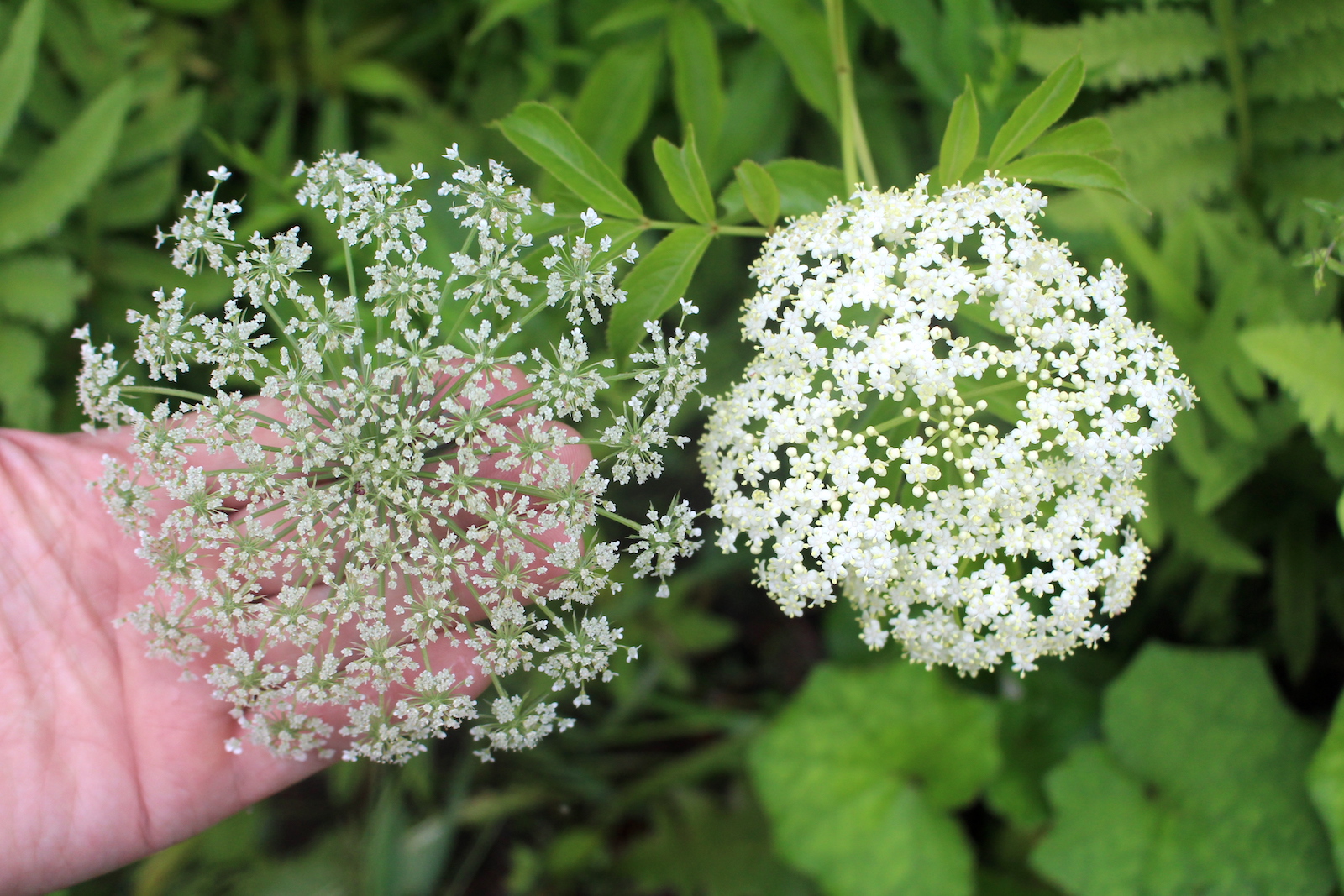
Ways to Use Queen Anne’s Lace
Beyond its beauty in the field or garden, Queen Anne’s Lace has a number of medicinal and edible uses.
If you catch Queen Anne’s Lace before it has bloomed, you can harvest the small but sweet roots and use them cooked or raw as you would carrots. The leaves can also be used cooked in soups and stews, but remember that some people are sensitive to them, so you may want to use gloves to harvest.
The flowers are tasty when harvested fresh, dipped in batter, and fried similarly to dandelion or squash blossom fritters. They can also be used to create jellies and fermented beverages similar to elderflowers. (Using an elderflower jelly recipe or an elderflower wine/mead recipe would work with these flowers as well.)
Queen Anne’s Lace fruits are also edible, and you can experiment with adding them to different recipes for their flavor and carminative properties, which help reduce gas and bloating.
For medicinal use, hot water preparations are best for Queen Anne’s Lace. Hot water helps extract essential medicinal compounds, so it’s best to use Queen Anne’s Lace in teas, decoctions, and infusions. Often, herbalists used the flowers, fruits, or roots rather than the leaves in medicine.
If you’d like to use Queen Anne’s Lace externally, some herbalists recommend finely grating the roots and adding them to oil to help soothe skin issues. You could also try creating an herbal soak from the roots and flowers. Just try a bit at first on a small patch of skin to ensure you don’t have sensitivity to the plant.
You can also use Queen Anne’s Lace as a natural dye. Fiber artists use the plant to create natural cream and yellow colors.
Queen Anne’s Lace Recipes
- Cook a batch of gluten-free Queen Anne’s Lace fritters with this fun recipe from Mossy Goat Farm.
- Preserve a bit of your summer harvest with this Queen Anne’s Lace Jelly recipe from Edible Wild Food.
- Make your own fizzy beverages with this Wildcrafted Queen Anne’s Lace Soda with Peaches recipe from Nitty Gritty Life.
- Have some fun experimenting with the fruit of Queen Anne’s Lace with this Queen Anne’s Lace Cognac Cocktail from Food52.
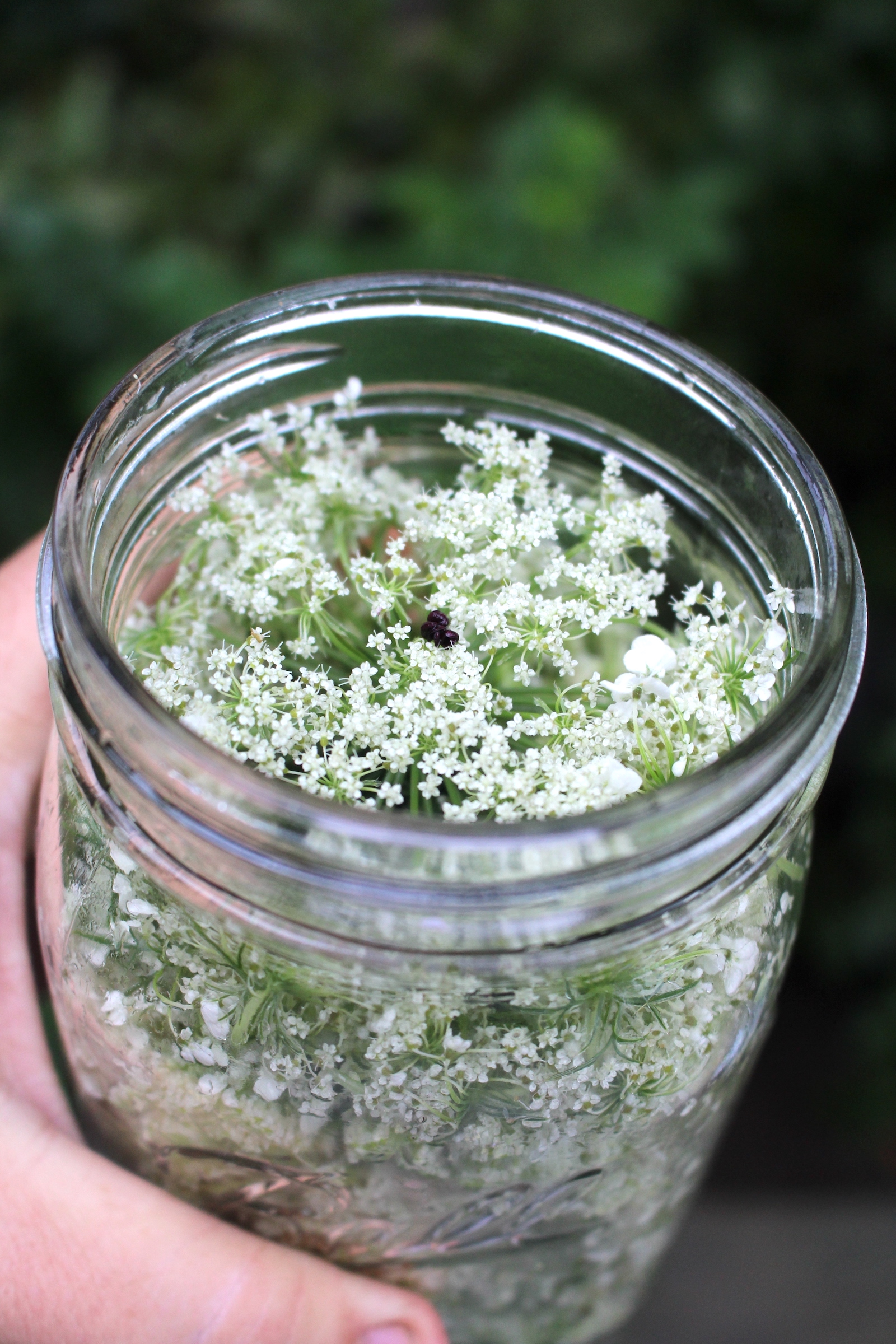
Edible Wild Roots and Tubers
Foraging other wild roots and tubers?
- 20+ Edible wild roots, tubers, and bulbs
- Foraging Spring Beauty (Fairy Potatoes)
- Foraging Burdock
- Foraging Evening Primrose
- Foraging Mullein (yes, the root is edible)
- 12+ Dandelion Root Recipes
Edible Wild Weeds
Looking for other edible wild weeds?
